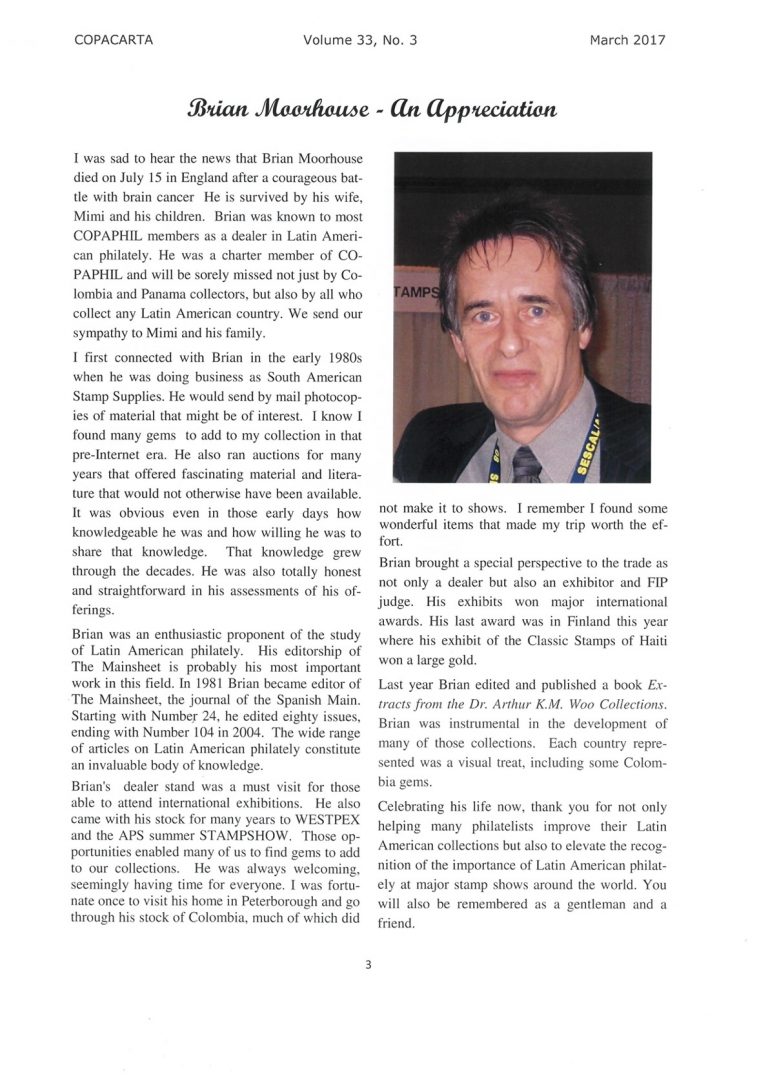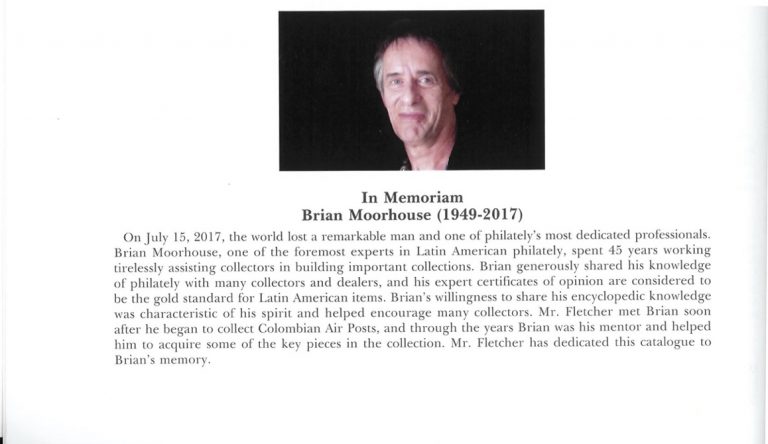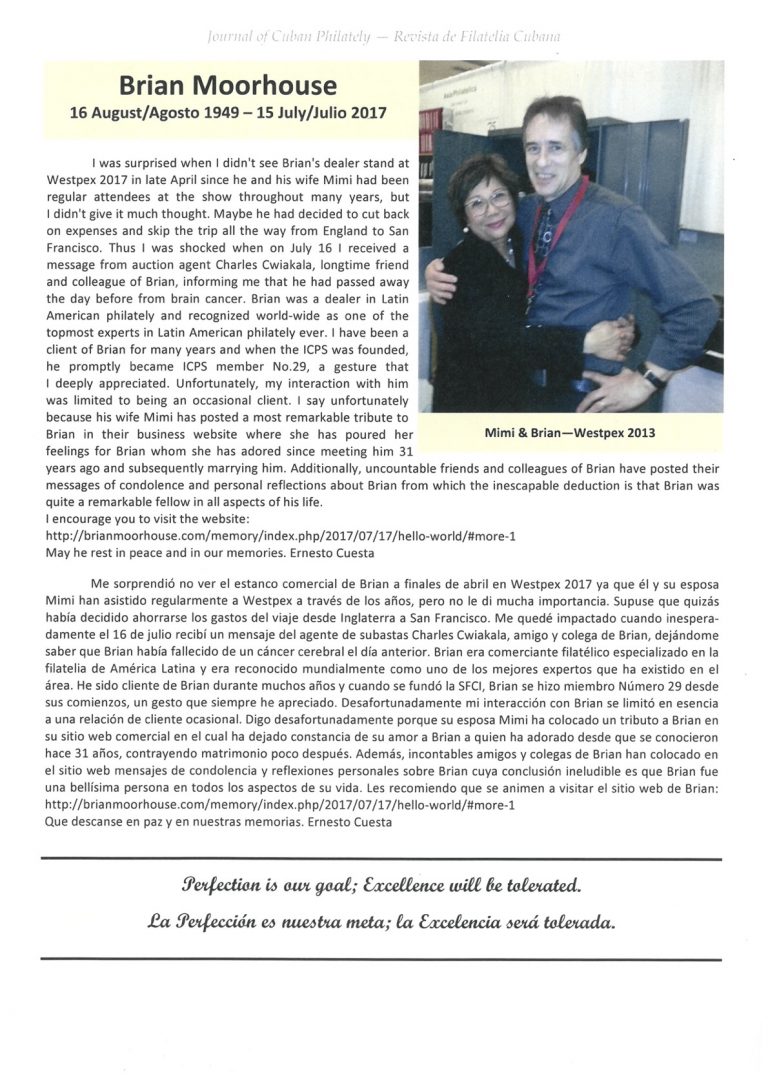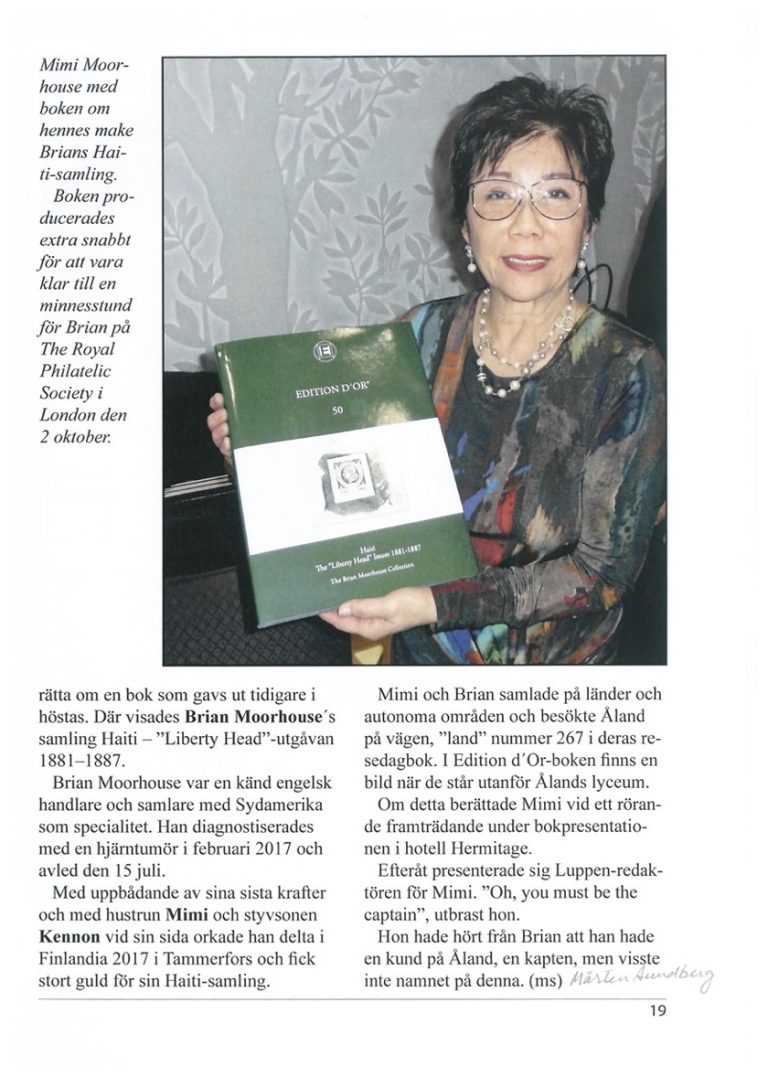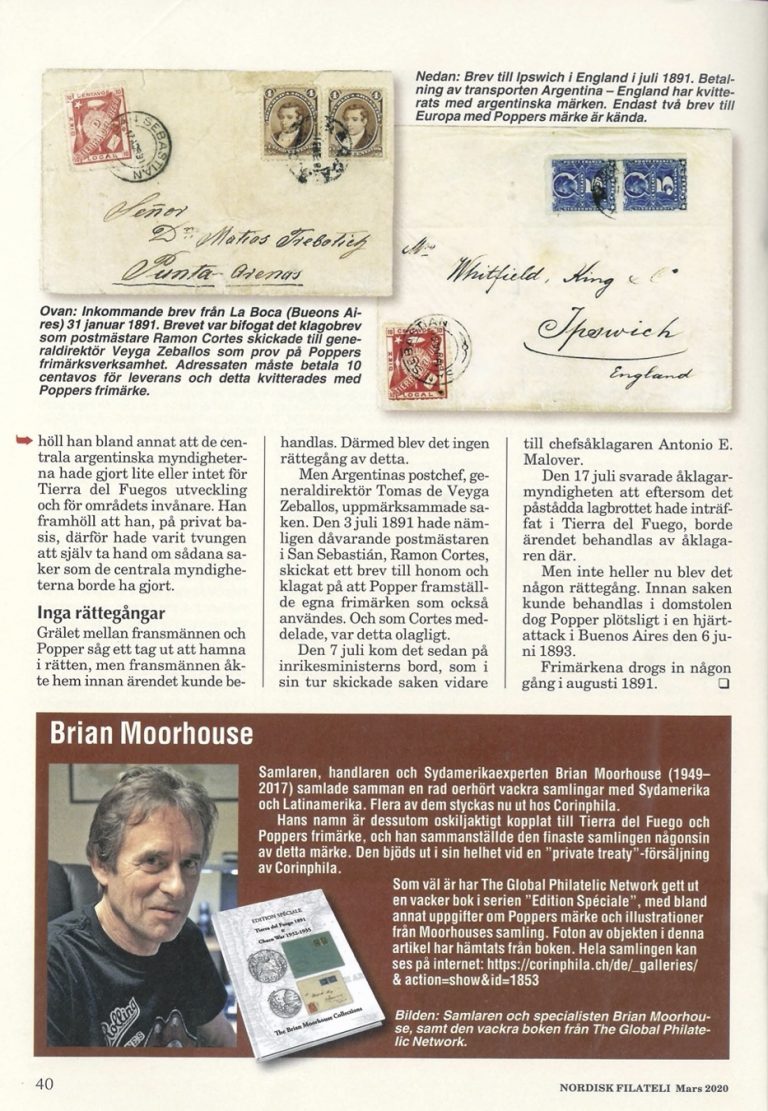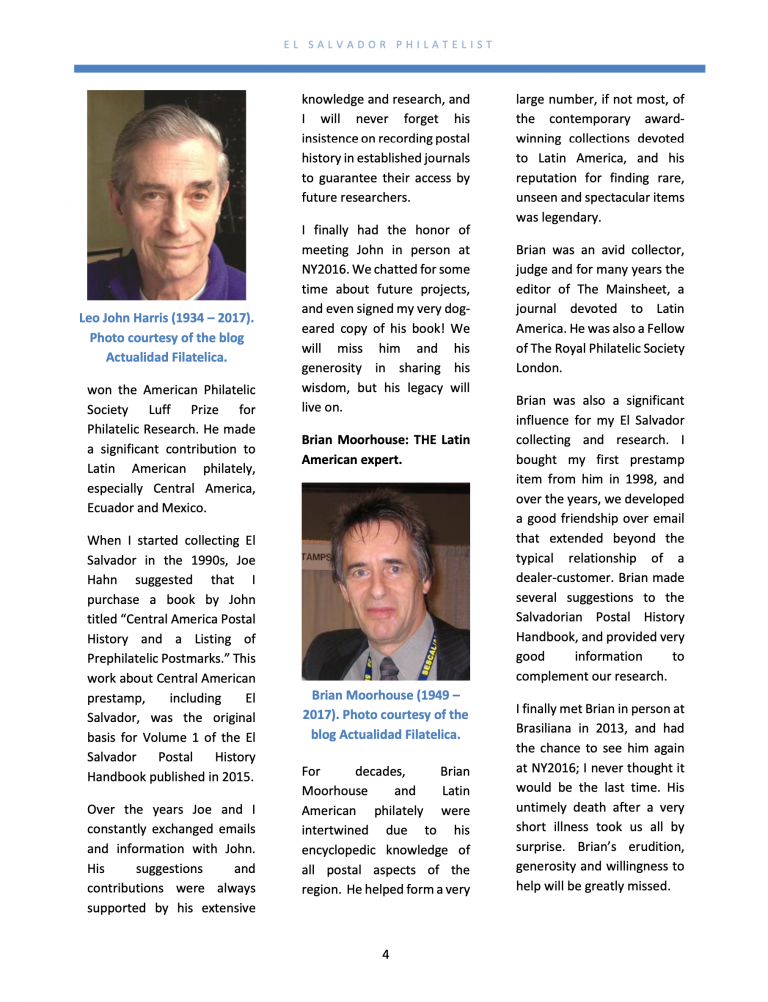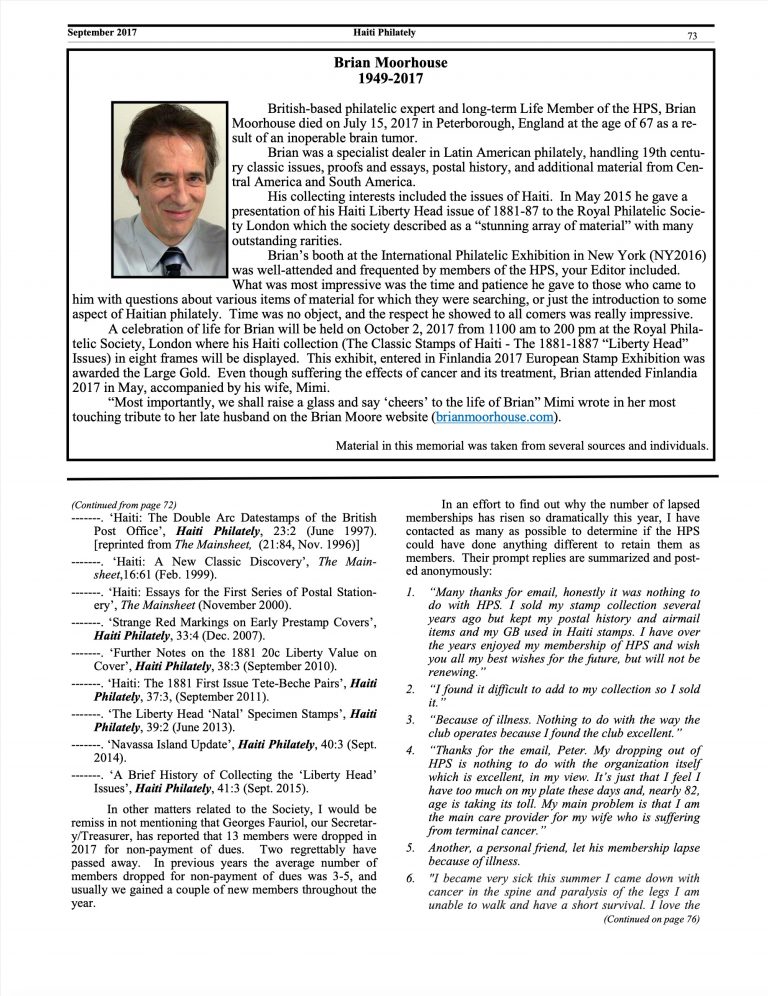Brian Moorhouse — A Philatelic Giant
By Dr. Norman S. Hubbard . Oyster Bay - New York
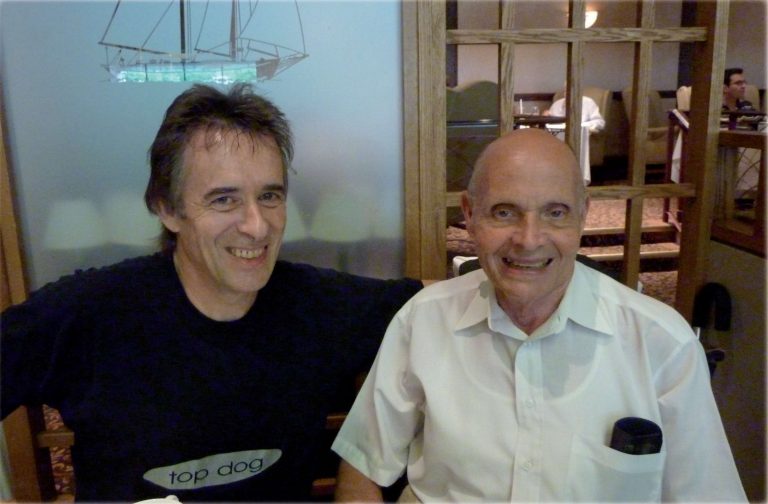
Brian Moorhouse died on July 15, 2017. He had been the undisputed King of Latin American Philately for 40 years. Over those years he developed it to a level it had never reached previously.
At the age of 16 Brian started experimenting in many business ventures which are described in detail by Mimi. His first real exposure to philately occurred when he became the advertising manager for Harris Publications at the end of 1968. In that role, he created advertisements relating to stamps. He had a mild familiarity with them dating back to his childhood. He started accumulating stamps by buying and selling them at local auctions and shows using the spare income he was earning at Harris. He did quite well financially because of his various talents which served him well in philately.
Ultimately Brian decided to leave Harris and become a full-time stamp dealer in 1972. He recognized that Latin America was the most neglected major area of philately. He had written nothing about it while at Harris. There was no serious competition for him. He formed South American Stamp Supplies which specialized in all Spanish speaking countries south of the United States as well as Portuguese Brazil. This turned out to be a brilliant decision which substantially influenced the rest of his life. As Yogi Berra said, “When you come to a fork in the road, take it.” Brian certainly did.
Brian realized that he had to build up a base of collectors to whom he could sell and dealers from whom he could obtain the material. He described auction lots for London Stamp Exchange on John Adam street in London, had space in some of its auctions, and shared booths with London Stamp Exchange on many occasions. The link with London Stamp Exchange was important in establishing contacts with many collectors including this writer.
More contacts were established when Brian attended International philatelic exhibitions. After a brief excursion to Europe in 1978, his first important trip was in the fall of 1979 when he traveled to Argentina, Brazil, and Uruguay. He met dealers and collectors in person, many of whom were new to him and him to them. He impressed all with his knowledge, dedication, and integrity. He always kept his word. This solidified his standing in South America for 40 years. Learning from this experience, he regularly took booths at exhibitions particularly in the United States.
Another important element in the growth of South American Stamp Supplies was Brian’s conversion of the Main Sheet into a house organ and a unifying force in Latin American philately. The magazine had been published for 6 years before he took it over. His first issue was number 24 in October 1981. He edited and published it for the next 22 years. It included research articles and comments on all Latin America. It was the main source of information for interested parties.
Brian studied intensively all aspects of Latin America. He became the recognized expert. His opinions and certificates were the gold standard demanded by collectors and professionals. He was a valued consultant of the Royal Philatelic Society expert committee and was relied upon by all.
Brian developed more collectors of Latin America throughout the world than there had ever been. He never lost the perspective of service. He considered each collector individually and suggested areas which would be interesting, stimulating, and fulfilling without being frustrating. This might involve unpopular countries, middle issues, proofs, revenues, or postal stationery. The alternatives were endless, determined by individual tastes.
When an area had been selected, Brian would search for items to improve the collection and excite the collector. He would patiently explain their importance, generously sharing his knowledge. He would always lead in the correct direction. If desired, he and Mimi could assist in writing up a collection and preparing it for exhibition. In order to prepare properly, Brian would carefully analyze the rules and grading of international exhibits. These changed considerably over the years. He would adjust accordingly. He never neglected his legions of customers with whom he achieved remarkable rapport.
Brian’s love of stamps was far deeper than merchandise to be bought and sold for a profit. He formed collections in many areas including the magnificent collection of Haiti which is displayed here. When he found an item he wanted for one of the collections, he would be as excited as any collector. He would call me describing enthusiastically the acquisition he had just made. He would be at that point a pure collector, not a dealer. He not only formed collections, but he shared them over the years by exhibiting, lecturing, and writing. Following is a list of the Latin American exhibits he personally built.
— Argentina — Buenos Aires 1858-1859
— Argentina — Corrientes 1856-1878
— Bolivia — 1867-1868 — The First Issues
— Colombia — 1868-1878 — The Pre-UPU Issues
— Costa Rica — 1870-1882
— Guatemala 1879-1882 — Quetzal Issues
— Haiti, the first issue
— Honduras — The Locomotive Issue
— Honduras — The Arias Issues
— Nicaragua — The 1882 UPU Issues
— Nicaragua — the Officials
— Paraguay — 1870-1878
— The Chaco War — 1932-1935
— Tierra del Fuego
In addition to stamps, Brian had a most important philatelic library devoted to Latin America. Again, he was the true collector adding material when possible. He shared the library with committed philatelists by making it available to them at his home. He would welcome them, listen to their problems, and lead them to the best books if he could not resolve the issue himself. He often could because of his vast knowledge of all Latin America.
Brian also supported philatelic societies in each country by publicizing them and contributing to their publications. He did this at the same time that he was producing his own auction catalogs and Main Street. He edited and published a magnificent book on the Arthur Woo collections commemorating the journey of Arthur through philately. Furthermore, he became an internationally accredited judge and represented Latin America on the jury at numerous international philatelic exhibitions.
Brians passing is a devastating loss to Latin American philately. It leaves a huge hole with no obvious successor in sight. We can only hope that someone will be able to do what Brian did for 40 years.
Brian, Tennis and I
By Dr. Alex O'Reilly
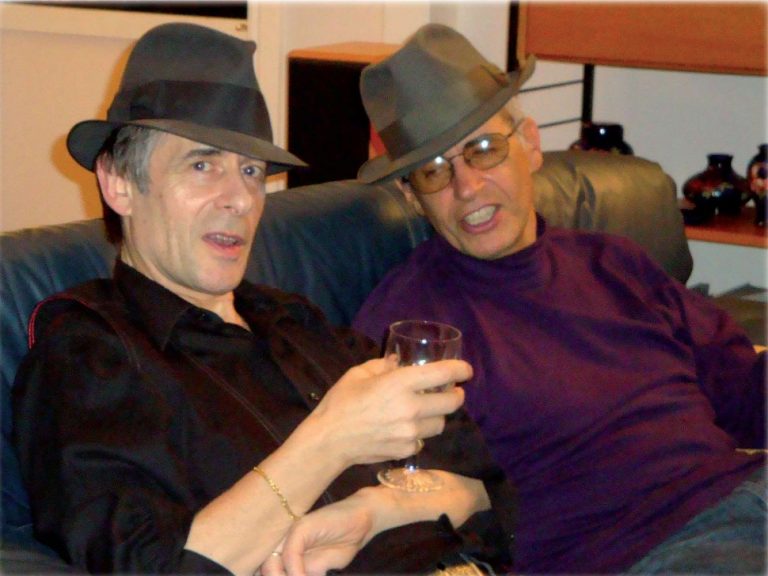
Brian loved tennis. He loved playing and watching tennis. He preferred playing singles. He was very competitive when he played. When we played, I always felt tense as he brought so much pressure and intensity to the court. It was, I felt, like how professionals must feel when they play matches. It wasn’t exactly enjoyable but it deepened the value of winning and losing and heightened the experience. I measured how well my tennis was by my performance against Brian.
He came to play tennis only 20-25 years ago. He joined Eastfield and had a few lessons with the coach, John Rudd. He soon started to improve. We would play singles on the hard courts at Town Tennis club. At first, | won easily with my serve and volley game. But as time went on, | started to lose more frequently. He was very fit and fast. Now he was returning my serves with interest and passing me more and more at the net. He always seemed to be able to put the ball where I least wanted it and if my shots were not strong enough, he would step up and take the point.
Brian told me he had a shoulder problem which did not allow him to serve with power and also necessitated a double backhand. He learned to vary the height, direction speed of the serve, like a slow bowler in cricket. His backhand became solid, like Del Potro’s, returning on a length until he would receive a forehand. He was very strong on the forehand side, driving down the line or hooking short across court. And of course there were his lobs, pin point accurate with a touch of top spin to take them even further away from you.
When the LTA brought in ratings, he chose 7.2. This was quite high. He soon proved he was worthy of it. A lot of “better” players (younger, harder hitting) found themselves losing to the old man.
He changed my game to a base line one, his strength, and took away my strength. I resorted to having coaching to meet the challenge. Our results in the last year were becoming more even again. What was making the difference in winning and losing, was the error rates. His error rate was usually very low. Though he didn’t like losing, if it was due to his standards falling he would become quite angry. This was never personal and also in real contrast to his off court nature. He was funny, informed, intelligent and warm. | have lost a playing partner who by his pressure and improvement, improved my game. More importantly, I have lost a good friend.
With Gratitude:
On 28™ August 2017, the Peterborough Town Tennis Club held a charity tennis day in memory of Brian specifically for raising money to the Thorpe Hall Sue Ryder hospice.
On 18″ October 2017, Brian‘s main tennis club for over 20 years — the Virgin Active Sport Club (now David Lloyd Sport Centre) — will be sponsoring a tennis day in memory of Brian to raise funds for supporting the Thorpe Hall Sue Ryder hospice.
Philatelic Societies
